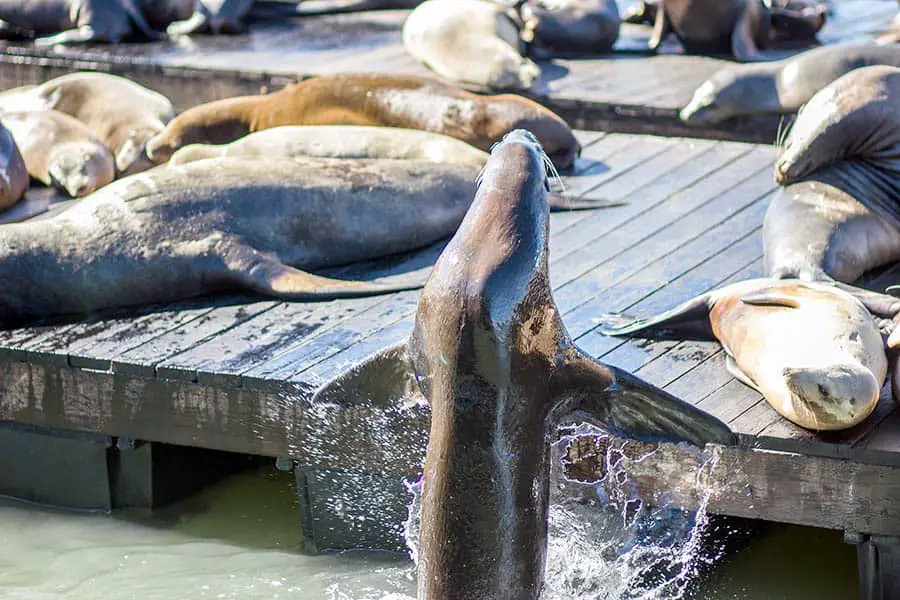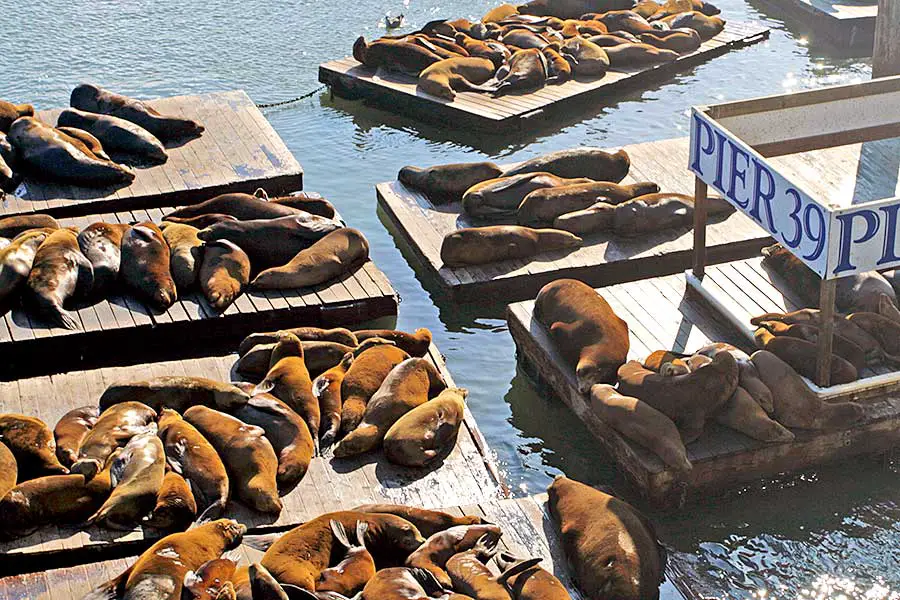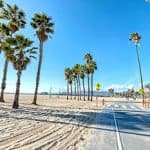
Visitors to San Francisco will enjoy seeing the local marine life. The Bay Area hosts some of nature’s most amazing creations, and very few of them are quite so adorable and fun as the seal. Or is it the sea lion? Which one is it – does San Francisco have seals, or does it have sea lions?
San Francisco hosts both seals and sea lions. Wildlife lovers can head down to Pier 39 to watch the playful sea lions frolic, bark, and swim on the docks. Those seeking a glimpse of a harbor seal can find an overlook to gaze out over the waters to try and spot one of these watchful creatures.
So what exactly is the difference between these marine mammals? Where are the best places to go to see them? Are they native to the environment, or did they end up here on accident? The playful, endearingly cute, and engaging nature of these animals makes us naturally curious to learn more about them. Brush up on your marine biology below.
Seals or Sea Lions – What’s the Difference?
Seals and sea lions seem pretty similar – it can be hard to remember which is which. Both of these marine mammals belong to a sub-order called Pinnipedia and are referred to by scientists as pinnipeds. These creatures are roughly torpedo-shaped with wide torsos and narrow posteriors. They are graceful and swift when in the water but somewhat clumsy on land. Pinnipeds have slit-style nostrils that close underwater and usually do not have large external ears.
So what are some of the differences between seals and sea lions? First, their fins. Sea lions have long, dextrous flippers on their front end, which they will use to walk on land. Seals have smaller flippers, and when on land, they primarily use a wriggling motion to crawl on their bellies.
Second, sea lions have visible ear flaps. Look just aft of their eyes, and you’ll see two cute little stubs wiggling and waggling in the breeze. Seals do not have any external auditory organs, and the casual observer is unlikely to be able to see the tiny holes that make up a seal’s ears.
Third, sea lions are very vocal animals. Anyone who has been near a sea lion colony, or perhaps seen a captive individual in a zoo or aquatic park, has probably heard the loud barks that sea lions use to communicate. Seals are much quieter and vocalize with quieter grunting noises.
While both seals and sea lions can live on the land, sea lions have an advantage out of the water: their front flippers allow them to move in a “walking” fashion. Seals, with smaller, webbed fins, must belly-crawl, making them rather inefficient on the land. Underwater, both of these species are highly aquadynamic and graceful.
In terms of their social behavior, seals are mostly solitary, where sea lions enjoy a vigorous social life. Most species of seals spend their lives in the water, coming ashore only to mate. Sea lions hunt in the water but frequently come ashore to gather in large social groups called rafts which can sometimes consist of more than 1,500 individuals.
Finally, sea lions and seals are different in size. Seals are generally between five and six feet long and weigh about 200 pounds as adults. Your average California sea lion, on the other hand, is between six and eight feet long and weighs around 660 pounds.
Both of these marine mammals are easy to spot in the Bay Area. The gregarious and blustery sea lion is easier to spot as they gather in rafts and make a distinctive barking noise. Harbor seals may be a little stealthier but can be spotted out in the waters of the bay.
Where Can I see the Sea Lions in San Francisco?

One of the best locations to see the sea lions in San Francisco is Pier 39. Back in 1989, a local group of California sea lions decided to gather on K-dock at Pier 39. With a rich natural food source (the bay) close at hand and a protected spot to roost, K-dock was an unintentionally perfect spot for the sea lions to gather. Researchers at the Marine Mammal Center advised the city to let the sea lions stay on the dock, and the sea lions have only been too happy to oblige.
Can I see Sea Lions Anywhere Else?
If Pier 39 is not for you, you can always travel to the Marine Mammal Center just across the Golden Gate Bridge. Beachcombers along Baker Beach or Aquatic Park Cove should keep their eyes open, as they might just catch a sea lion swimming or basking in the area. Ocean Beach is known to attract these playful mammals too.
Bay Area Answers Fun Fact: While the average California sea lion weighs in at around 600 pounds, the enormous Steller sea lion can grow up to ten feet long and weigh more than 2,200 pounds. A Robinson R44 helicopter, such as you might sightsee in, weighs about 1,450 pounds.
Is a Particular Time of Day Better to see the Sea Lions?
Morning and evening are the best times of day to view these mammals out of the water. Like us, they enjoy a mid-day meal and thus often spend the body of the day hunting for food in the water.
Other Posts of Interest
- Does San Francisco Have a Beach?
- Is Pier 39 the Same As Fisherman’s Wharf?
- Why Is The Golden Gate Bridge Red?
- Is Ghirardelli Chocolate Made in San Francisco?
What Time of the Year is Best to See Sea Lions at Pier 39?
Pier 39’s famous raft of sea lions is visible most of the year. However, during the early summer months of June and July, many sea lions venture down to the Channel Islands to mate. You’re most likely to see the sea lions at the pier between July and May.
Where Can I go to See Seals in San Francisco?

Unlike sea lions, seals spend most of their time at sea. They are also not especially sociable with one another, meaning that they do not tend to congregate in large groups the way sea lions do. This antisocial tendency makes them harder to find.
Your best bet to see a seal is to head out onto the water – perhaps consider a harbor tour – and watch carefully. They come up for air periodically, and if you’re attentive, you will likely be able to see one surfacing to breathe.
Are There Different Kinds of Sea Lions and Seals?
There are a variety of species of sea lions and seals. In San Francisco, the most common sea lions are California sea lions. The most commonly observed seal is the Harbor Seal, although if you want to see Elephant seals, you can drive south about an hour and a half to Año Nuevo State Park, where these magnificent beasts like to lounge and swim.
How Close Can You get to Sea Lions and Seals?
Sea lions and seals are wild animals. As such, it is in their and our best interests to keep a respectful distance. While they may occasionally decide to beach or to rest on a human structure, this is not an invitation to approach them. NOAA recommends that people maintain a distance of at least 50 yards, or about half a football field, from marine mammals.
Can I Feed the Seals or Sea Lions?

No. It is not allowable to feed the seals or sea lions – it may be harmful to the animals, and it is illegal. You also must not touch, swim with, ride, or otherwise harass or interact with marine mammals. They are best enjoyed with your eyes, or even better, through a camera lens or some binoculars.
Are Sea Lions and Seals Dangerous? Can Sea Lions and Seals Kill Humans?
Any wild animal can be dangerous, especially if human beings are accosting, harassing, or otherwise annoying them. Seals and sea lions are no exception. While a seal is unlikely to kill a human, they have been known to bite or attack boaters or fisherman. Feeding seals is illegal and can also drive the animals to develop more aggressive behaviors.
Sea lions can also be dangerous. In areas where they mingle with humans, such as near Pier 39, there have been instances of sea lions behaving territorially, in some cases biting swimmers on the legs – one unfortunate man had a punctured bone after a sea lion bite. In other instances, sea lions have attacked surfers or people being towed by boats. While they are not aggressive toward humans by nature, they can be dangerous, and they could potentially kill a human being.
The best way to enjoy these creatures is from a safe distance, through a lens.
Sealing the Deal
The San Francisco Bay area offers some of the most satisfying encounters with marine life you can have. It is important to enjoy the wildlife in a respectful way. Harassing, chasing, feeding, or otherwise bothering the marine life can be damaging to their health, and in turn, damaging to our ecosystem. These remarkable marine mammals should be enjoyed respectfully, from a distance.
That said, correctly engaging with these animals is a rewarding experience. Snapping the perfect photo of a playful sea lion or an adorable seal among the waves is a great way to remember your San Francisco experience. Observing the sea lions with binoculars and watching them slide in and out of the water can be awe-inspiring. It is well worth your time to enjoy these creatures the right way.





